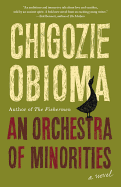
| Publisher: | Little, Brown | |
| Genre: | Cultural Heritage, Literary, Coming of Age, Fiction | |
| ISBN: | 9780316412391 | |
| Pub Date: | January 2019 | |
| Price: | $28 |
| Starred | Fiction |
by Chigozie Obioma
An Orchestra of Minorities by Chigozie Obioma (The Fishermen) is a tragic look at how binding oneself to a singular purpose can both give life new meaning and destroy it. Narrated by the chi (guardian spirit) of a young man living in Nigeria, the novel is a sprawling look at the country's past and present.
It's a love story between Chinonso and Ndali, a woman far above him in caste and learning. The two meet by chance when he sees her preparing to jump off a bridge to her death. He succeeds in stopping her, and they fall in love, much to the chagrin of her family. A poor poultry farmer, Chinonso has none of the attributes her parents expect in a suitor, and he is ostracized for his failures. At the urging of an old schoolmate, he sells his family's property to enroll in university in Cyprus, hopeful that by returning with a degree he can win over Ndali's parents. But his schoolmate's encouragement turns out to be a ruse, and Chinonso is left penniless on the Mediterranean island, beginning a years-long journey back to Ndali that forever changes them both.
The Odyssey is mentioned offhandedly on a couple of occasions, but An Orchestra of Minorities plays like a dark satire of that foundational text of Western literature. And the chi narrates with the weariness of a creature who has seen all facets of human suffering. Ultimately, An Orchestra of Minorities is a powerful look at the opportunities and ruin that lay before a man in pursuit of his dreams. --Noah Cruickshank, adult engagement manager, the Field Museum, Chicago, Ill.
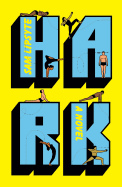
| Publisher: | Simon & Schuster | |
| Genre: | Humorous, General, Satire, Literary, Fiction | |
| ISBN: | 9781501146060 | |
| Pub Date: | January 2019 | |
| Price: | $27 |
| Fiction |
by Sam Lipsyte
Teeming with its share of dubious gurus and generating nearly $10 billion in annual revenue in the United States, the self-help industry offers an inviting target for mockery. It seems inevitable, then, that a satirist with the gifts of Sam Lipsyte (The Ask) would take on the challenge. Hark, his fourth novel, is the irreverent story of a reluctant apostle and his motley band of acolytes. They make efforts to spread the gospel of a pseudo-mindfulness technique that's about as substantial as a wisp of wind.
Hark Morner is a young comic who's found a profitable gig at corporate team-building events, where he's billed as an "expert in some esoteric practice--knife yoga, reverse hypnosis." He calls his concept "mental archery," inspired by a toy bow he found sticking out of a garbage can. In Hark's mind, the sole purpose of this half-cooked stew of pseudo-psychological teaching is to improve its practitioners' focus. But, in truth, there are "no ideas in mental archery, or no complex ones, just poses, mini-wisdoms, historical nuggets of dubious accuracy. Pearlescent shoals of the stuff."
Hark is relatively light on action, deriving most of its appeal from Lipsyte's darkly comic sensibility, edgy dialogue and the ferocious exaggeration of its premise. But in its final third, the novel takes a decidedly more serious turn, as mental archery migrates from the corporate world to the larger culture and the plot gains some welcome momentum.
There's not much that's gentle about Sam Lipsyte's touch, but readers who enjoy fiction that delivers social commentary with a palpable sting will find themselves at home here. --Harvey Freedenberg, freelance reviewer

| Publisher: | Harper | |
| Genre: | Psychological, Women, Family Life, General, Literary, Fiction | |
| ISBN: | 9780062476692 | |
| Pub Date: | January 2019 | |
| Price: | $26.99 |
| Fiction |
by Tessa Hadley
More than 30 years of love and friendship--and the loyalty and betrayals therein--are central to Late in the Day, a psychologically astute novel by Tessa Hadley. The story launches with a death that disrupts the lives of two British couples bonded inextricably since their college years.
Zachary Samuels, one of the four, dies suddenly from a heart incident. The death of this middle-aged gallery owner overwhelms his needy, helpless wife, Lydia. And this tragic news also shocks the lives of Lydia and Zachary's closest friends: Christine, an artist who had many showings at Zach's gallery, and her husband, Alexandr, a poet who gave up his writing dreams to become headmaster at a progressive primary school.
Zach is absent throughout the narrative, but his presence looms large in these three lives--and those of the offspring of each respective couple. In Zach's wake, roads not taken are reconsidered, affections shift and old wounds and jealousies are resurrected. This all leads to responses and actions that ultimately upend these once seemingly settled lives.
As in her other work, Hadley (The Past) has a firm grasp on the complexity of grief and the strengths and foibles of human nature. This exquisitely rendered, character-driven novel probes emotional depths of an ensemble cast of ordinary people who are forced to come to grips with the meaning of life through loss and death. --Kathleen Gerard, blogger at Reading Between the Lines

| Publisher: | Dzanc Books | |
| Genre: | General, Absurdist, Literary, Fiction, Jewish | |
| ISBN: | 9781945814457 | |
| Pub Date: | December 2018 | |
| Price: | $16.95 |
| Fiction |
by Curt Leviant
If one threaded Vladimir Nabokov's obsessive eros through an exploration of religious devotion, it might look something like Curt Leviant's superbly entertaining Katz or Cats: Or, How Jesus Became My Rival in Love.
Like Russian nesting dolls, the novel is relayed as a novel within a novel. John, a book editor, meets the land surveyor Katz on a New Jersey train. Katz shares with John a manuscript his brother wrote about falling in love with a religious woman named Maria. Leviant has tremendous fun with this self-reflective narrative structure. John is bewildered more than once as he tries to determine fact from fiction, Katz from his twin brother--also named Katz--and just how much the former is revising and reshaping the novel as it's being told.
But it is the story of Maria that steals the show. Katz, the twin brother, falls hard for the single, aloof, cat-obsessed Maria, who is torn between sexual desire and her Christian piety. She admits she loves Katz but loves Christ even more and eventually stops sleeping with her lover. Thus Katz, who's Jewish, must compete with an entire theology. "Oppressed by the dense melancholy of memories," he obsesses about how to get Maria back into the bedroom. Leviant uses the conflict to explore both sexual love and religious devotion, suggesting the two are related. The sex scenes have an ecstatic quality, likened to musical scales, and the repartee between the two characters is filled with witty wordplay.
Katz is a heady love story worth the narrative convolutions. Funny and sad at the same time, the novel manages to get at the heart of something profound. --Scott Neuffer, writer, poet, editor of trampset
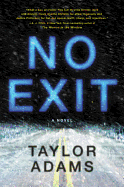
| Publisher: | Morrow | |
| Genre: | Psychological, Crime, Suspense, Thrillers, Fiction | |
| ISBN: | 9780062875655 | |
| Pub Date: | January 2019 | |
| Price: | $26.99 |
| Starred | Mystery & Thriller |
by Taylor Adams
"There's a child locked inside this van." The realization sends a shot of fear through Darby Thorne's body, as she peers through the back window of a vehicle parked at a snowed-in rest stop located in the middle of nowhere Colorado. There are four others there to sit out the blizzard: two young men and a middle-aged couple. But which is responsible for the young girl locked inside the van?
That's only the first question that Darby must answer in Taylor Adams's heart-thumping thriller, No Exit. A filmmaker as well as a novelist, Adams (Our Last Night) delivers a story that moves at breakneck speed with more suspenseful twists and turns than an icy mountain road. Set over the course of a single night, its chapters are broken up by the hour, making the events seem to pass in real time.
Darby, meanwhile, is an unexpected hero: a sheltered but cunning college sophomore with a history of stealing her mother's car and lying with a straight face, skills that come in handy when trying to outwit a crafty kidnapper. She's also immensely likable; her comebacks when facing off against the enemy are hilariously withering. Humor is everywhere in this novel despite its dark premise. The trapped nine-year-old possesses an equally sharp wit, and the strangers in the rest stop all have their own clever moments. Suspense is still the dominating mode, though, and from beginning to end, it never lets up. --Amy Brady, freelance writer and editor
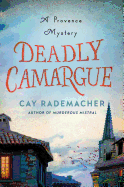
| Publisher: | Minotaur Books | |
| Genre: | Police Procedural, International Mystery & Crime, Mystery & Detective, Fiction | |
| ISBN: | 9781250110725 | |
| Pub Date: | November 2018 | |
| Price: | $26.99 |
| Mystery & Thriller |
by Cay Rademacher
Roger Blanc, recently exiled from Paris to the Provençal police force, is called to the scene where the body of a cyclist lies. It was found on the road through the Camargue--a marshy area known for its flamingoes, white horses and fierce bulls.
The dead man was gored by one of the bulls that was being reared to fight. Everyone assumes it's a tragic accident, until Blanc realizes that the dead man is famous reporter Albert Cohen. He also finds evidence indicating that the bull was deliberately freed from its pen. Blanc's superiors are reluctant to make a murder of a probable accident, but Blanc refuses to back down. Then he discovers that Cohen was writing an article about Vincent van Gogh's time in Provence, which opens up a new realm of suspects in the art world.
Ably capturing this region of France, with its shimmering heat and fields of red rice, Cay Rademacher (Murderous Mistral) has crafted a curious mystery set in an unusual world. While Blanc's original "crimes" (which cost him his position as an officer in Paris) are never specifically mentioned, his stubborn refusal to back down in this case is a clear indicator of his tenacity. Yet Blanc's nuanced character, and those of his fellow officers--a drunkard, and a lesbian fighting for the right to marry--keep Deadly Camargue fresh. The van Gogh element is a delightful twist on a typical mystery, sure to make this one appeal to mystery lovers and art aficionados alike. --Jessica Howard, bookseller at Bookmans, Tucson, Ariz.
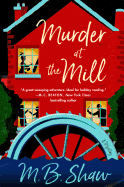
| Publisher: | Minotaur Books | |
| Genre: | Mystery & Detective, Crime, Cozy - General, General, Thrillers, Fiction, Women Sleuths | |
| ISBN: | 9781250189295 | |
| Pub Date: | December 2018 | |
| Price: | $27.99 |
| Mystery & Thriller |
by M.B. Shaw
M.B. Shaw is the pen name of British writer Tilly Bagshawe, who has written several contemporary romance novels (Scandalous), as well as thrillers for the literary estate of Sidney Sheldon (Sidney Sheldon's The Tides of Memory). Murder at the Mill is the first installment of her smart, lively mystery series; in it Shaw probes the secrets of an idyllic Hampshire village.
The book opens in December. Iris Grey--a 41-year-old portrait painter--has fled her home in Clapham and her estranged husband, Ian McBride, a once successful playwright. After several years of failing to conceive a child via in vitro fertilization, the couple--heartsick and broke--has split up. Iris had hoped that by settling in to Mill Cottage in Hazelford ("Alone. Like a mad cat lady, only without the cats") she would "paint and hide and lick her wounds." Shortly after her arrival, however, she's commissioned to paint a portrait of resident Dominic Wetherby, a charismatic and famous crime writer. During the Wetherbys' posh Christmas party, a corpse is discovered in the river. The shock leaves the family, townsfolk, gossipmongers and the paparazzi reeling. Speculations abound. Was the death an accident--or murder?
Shaw has created a wise and winning sleuth in Iris. Her keen, observational skills honed from her artistic sensibility allow her to detect subtle nuances of human emotion and motivation. This, along with an intricate, cozy plot--and fully realized characters embroiled in a dynamic whodunit and why--will keep readers guessing, and eager for future installments. --Kathleen Gerard, blogger at Reading Between the Lines

| Publisher: | Grove Press | |
| Genre: | Biography & Autobiography, Women, Self-Help, Personal Growth, Happiness, Personal Memoirs, General, Humor | |
| ISBN: | 9780802129062 | |
| Pub Date: | January 2019 | |
| Price: | $26 |
| Biography & Memoir |
by Marianne Power
Self-help is big business. Each year, consumers spend millions of dollars on books, courses and other tools that promise to make them thin, rich, irresistible or wildly successful. But does self-help actually help? British journalist Marianne Power decided to find out, by reading and following one self-help book per month for a year. After 12 months, she'd surely become--if not perfect--at least a better version of herself. Right?
Taking the form of a "stunt" memoir while also poking fun at it, Power's memoir, Help Me!, chronicles her journey (16 months in the end) of reading and emulating such self-help classics as The Secret and The Power of Now. She tries naked yoga, chats up men on the subway and delves into her troubled relationship with money. Initially, despite her enthusiasm, Power's journey leads to self-obsession rather than self-improvement; readers may cringe as she alienates several friends and brushes off a kind man. Overwhelmed by her own imperfections, she wonders if the project is worth it. But with the help of some stalwart friends and her no-nonsense mother (whose sardonic one-liners constitute some of the best advice in the book), Power begins to find her way forward.
She gains a few lasting insights, mostly having to do with living in the moment, accepting herself and asking for help when she needs it. Like most journeys, her self-help odyssey didn't lead where she expected it would, but her wry account is entertaining, sympathetic and even--perhaps--helpful. --Katie Noah Gibson, blogger at Cakes, Tea and Dreams
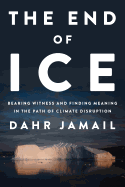
| Publisher: | The New Press | |
| Genre: | Nature, Life Sciences, Environmental Conservation & Protection, Science, General, Ecology, Global Warming & Climate Change | |
| ISBN: | 9781620972342 | |
| Pub Date: | January 2019 | |
| Price: | $25.99 |
| Nature & Environment |
by Dahr Jamail
The End of Ice is a series of reports from the front lines of climate disruption. Dahr Jamail (Beyond the Green Zone: Dispatches from an Unembedded Journalist in Occupied Iraq) bears witness to shrinking glaciers in Alaska, coral bleaching off the Rock Islands of Palau and much more. Instead of "climate change," Jamail prefers the term "anthropogenic (human-caused) climate disruption" to emphasize humans' responsibility for altering planetary climate systems. The End of Ice references catastrophic future scenarios that scientists have promised will result from climate disruption, but it is equally interested in the costs being exacted already. Jamail explains that "only by sharing an intimacy" with the places suffering from climate disruption can we "begin to know, perhaps love, and certainly care for them."
Jamail's love of mountaineering is a feature of many chapters, giving firsthand heft to his observations of Denali and the Gulkana Glacier. Similarly, through scuba diving, he is able to give a personal account of the suffering coral reefs. He backs up his observations with plenty of hard science, very little of it encouraging. Jamail also speaks to locals and experts, including some of the indigenous peoples whose ways of life are being threatened by climate disruption. The End of Ice is not among the many books that place an emphasis on ways to avoid worst-case climate scenarios, and readers might take issue with Jamail's seeming fatalism in that respect. Instead, the book offers an opportunity to mourn the natural wonders disappearing around us. --Hank Stephenson, bookseller, Flyleaf Books, Chapel Hill, N.C.

| Publisher: | Harper | |
| Genre: | Biography & Autobiography, Surgery, Personal Memoirs, Science, Plastic & Cosmetic, Medical, History | |
| ISBN: | 9780062656209 | |
| Pub Date: | January 2019 | |
| Price: | $27.99 |
| Health & Medicine |
by Joshua D. Mezrich
In When Death Becomes Life, transplant surgeon Joshua D. Mezrich explains the background of organ transplant through the lens of his own experience. Part memoir, part narrative history, the book looks at the major players in transplant medicine with notable contextual details. For example, Nobel laureate Alexis Carrel was inspired to study vascular surgery by the 1894 assassination of the French president, but his groundbreaking transplant research is largely overshadowed by the popular notion that he was a Nazi sympathizer. Mezrich, who tells jokes and plays Tupac in the operating room, walks readers through procedures step by gory step and describes the challenges doctors face outside of the OR: nonstop hours, weighing the risks of surgery and guilt and depression if something goes wrong. He also grapples with ethical questions, such as whether doctors should perform liver transplants on people with alcoholism.
Readers will quickly become acquainted with medical terms like "renal" and "cyclosporine," but the technical language is balanced by thrilling accounts of medical discoveries and the author's own surgeries. In writing about his life-saving career, Mezrich is both casual--"I was interested in learning liver transplantation (the Super Bowl of the abdomen), but I also wanted to have the opportunity to mess with the pancreas"--and reverent--"I'll never forget the simple beauty of the kidney transplant, the feeling of wonder when the kidney turned pink." He recognizes the great responsibility surgeons have and takes care to show the humanity in each patient, both organ donor and recipient. --Katy Hershberger, freelance writer and bookseller

| Publisher: | Schwartz & Wade | |
| Genre: | Values & Virtues, People & Places, Homelessness & Poverty, United States - African-American, Social Themes, Juvenile Fiction | |
| ISBN: | 9780375836152 | |
| Pub Date: | January 2019 | |
| Price: | $17.99 |
| Starred | Children's & Young Adult |
by Patricia C. McKissack, illust. by April Harrison
The late Newbery Honor and Coretta Scott King Award-winning author Patricia McKissack (Let's Clap, Jump, Sing & Shout; Dance Spin & Turn It Out!) joins with celebrated folk artist and illustrator April Harrison to capture the joy of giving in What Is Given from the Heart.
After his father's death, James Otis and his mother lose their farm and move to the Bottoms. There, the African American family of two try to rebuild their lives despite a lack of resources and continuous hardships. After a "skimpy" Christmas and new year, Valentine's Day approaches and their pastor implores his congregation to donate items for "love boxes" that will go to needy families, reminding them that "what is given from the heart reaches the heart." Though they don't have much at all, James Otis and his mother enthusiastically embrace the opportunity to use their talents to create gifts for another struggling family of two and are pleasantly surprised with how giving from the heart can quickly circle back.
Harrison's expressive collages combine found materials, acrylic paint and pen drawings to create texture and movement that matches the emotion in McKissack's colloquial dialogue and text. Details that Harrison develops--pictures drawn by James Otis stuck to the refrigerator, portraits mingling colors and shapes--perfectly complement the way McKissack frames the idea of an interconnected community, one that gives of itself and its people to sustain each other and survive. What Is Given from the Heart is a loving tribute to collective work, responsibility and the joy that comes from giving freely from the heart. --Breanna J. McDaniel, freelance reviewer
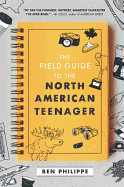
| Publisher: | Balzer + Bray | |
| Genre: | Humorous, Emigration & Immigration, General, Coming of Age, Social Themes, Young Adult Fiction | |
| ISBN: | 9780062824110 | |
| Pub Date: | January 2019 | |
| Price: | $18.99 |
| Children's & Young Adult |
by Ben Philippe
Norris Kaplan is about to start his junior year at a new school in Austin, Tex., where his Haitian/Canadian mother recently got a job. He's heard Austin has a "unique flavor" and, upon arrival, he discovers that "none of this flavor... [is] hospitable to your average Canadian. No, to your average Canadian--black French Canadian no less--Austin, Texas, [blows] baby chunks."
Generally pessimistic and especially sour about moving to "the surface of the sun," Norris is determined to hate everything. Which he does. Until Aarti Puri. "Dark skinned... with... artificially dyed dark red hair," Aarti is artistic, smart and probably not into him. But Norris makes a deal with cheerleader Madison when applying for a job at her family's restaurant: he'll cover shifts when she has practice and she'll help him with Aarti. Slowly, with Maddie's help, Norris starts hanging with cheerleaders, makes friends with a nice loner and goes on dates with Aarti--he's "an actual American cliché." All the while, Norris writes in his journal witty, self-satisfied "field guide" entries disparaging life in Austin and the people around him. That type of mindset can backfire, though, and, when it does, Norris might have to leave Texas altogether.
Norris is self-absorbed with a cutting inner monologue. He should be wholly unlikable, but Quebecois-turned-Texan Ben Philippe manages to make Norris a humorous, sympathetic protagonist, lovable yet ultimately responsible for every moment of his own downfall. Norris is selfish, but Philippe is aware, regularly forcing Norris to recognize the humanity of others. Philippe continues this awareness by developing fully rounded characters who don't fit into Norris's stereotypes; no one is only vapid, only smart, only mean, or only an athlete. Which is "kind of the point," right? --Siân Gaetano, children's and YA editor, Shelf Awareness